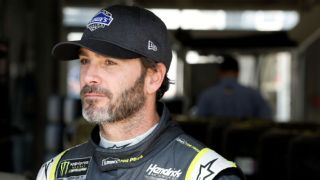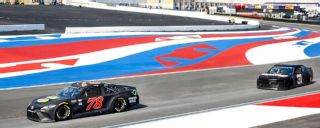|
CONCORD, N.C. -- During test sessions, NASCAR Cup Series drivers tend to try to figure out how to go fast. For their tests at the new Charlotte Motor Speedway road course, drivers also are trying to figure out where they must proceed with caution. The 2.28-mile, 17-turn course encompasses most of 1.5-mile oval and then a weaving trip through the infield between Turns 1 and 2 that includes some slight elevation changes. There also are backstretch and frontstretch chicanes to scrub off speed and create more passing. "You're not comfortable anywhere," said seven-time Cup champion Jimmie Johnson after posting the fastest speed at the test last Tuesday. "The whole time you're on pins and needles afraid you're going to bust your butt. There's not really a calm place around here." To help NASCAR organizations learn the track, NASCAR opted to have two test sessions -- one last Tuesday (July 10) and one set for this Tuesday (July 17). Each driver could choose which test session to attend, allowing multicar organizations to take what they learned in the first test and apply it to the second. There were 16 drivers at the July 10 test, and 14 drivers are expected Tuesday. At the first test, Johnson posted the top lap at 106.1 mph, followed by Denny Hamlin and Chase Elliott at 105.9, Kyle Larson and Kurt Busch at 105.4 and Chris Buescher and Martin Truex Jr. at 105.2. CMS has had a road course for decades, but it was reconfigured to add several turns over the last 18 months.  "It's a very, very tricky track in trying to link together a NASCAR track throughout some parking lots and some added chicanes and an existing road course," Johnson said. "I think attrition is going to be really high. It's very easy to make mistakes and have big problems when you make a mistake." The race for Cup cars will be 400 kilometers with stages of 25 laps, 25 laps and 59 laps. The race for Xfinity cars will be 200 kilometers with stages of 15 laps, 15 laps and 25 laps. "The track is tough to get a hold of, but the good thing is it's the same for everyone," said Brad Keselowski. "It's going to be really tough to go a whole race here without wrecking or tearing your car up. "The curbs are very aggressive. It's really tough on the tires and the bodies of the cars. It will be really interesting to see. This is a big test of man and machine, more than what we've had in quite some time." Aggressive curbs? "Sonoma has the curbs, but they are low-speed curbs," Keselowski said comparing the Charlotte road course to Sonoma's. "These are high-speed curbs. If you hit them a little bit wrong, you're going to wreck or tear your car up. It's just a different challenge than we normally have. "This track has 50 percent slow speed, 50 percent high speed corners, where The Glen [road course] is almost all high speed." The treacherous dynamic of the course was expected, as drivers have crashed in earlier tire tests. Bubba Wallace crashed in the 90 minutes of testing July 10. "I had a couple of panic moments along the way, but it wasn't as bad as I thought it would be from what I heard leading up to it," Buescher said. "It had more grip than I expected. ... We have a baseline and AJ gets to come back next week and work on more stuff."  One of the big questions is whether the course will be altered after the test sessions. During the July 10 test, NASCAR added additional speed bumps behind the rumble strips on the backstretch chicane so that drivers would just drive through the rumble strips and not make the turn as designed. "There was made to be a chicane to slow us down," Hamlin said. "[The change made] is going to make us respect that corner." NASCAR will not use the frontstretch chicane for restarts as it comes right before the start-finish line. That area could be one of the most likely passing zones in the track. "There is more time to be gained or lost coming off Turn 4 oval ... before you get to the start-finish line," Ryan Newman said. "It seems like that is the most challenging part of the track. You've got to be competitive in all of it. You can't give up anything." Buescher said the backstretch chicane -- also termed as a "bus stop" because it is a very short, quick turn -- is so tight, drivers will have to be single file through there. "I haven't figured out where exactly the passes are going to be yet," Buescher said. "How you get in the banking [coming out of the infield] can set you up to beat somebody to the bus stop. You're not going through the bus stop two wide. That would be a mess. "The one here [on the frontstretch] is probably your best passing opportunity. It's bumpy. The transition from the actual oval to that chicane is very rough. Hopefully we will be able to minimize lockup [of the brakes] and wheel hop."
|

